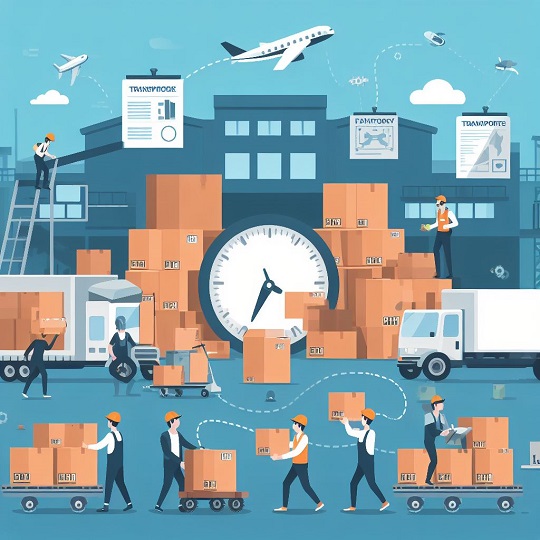Running a successful business in today’s competitive market involves numerous moving parts, and one of the most critical aspects is managing your supply chain efficiently. This is where a third-party logistics (3PL) provider can play a pivotal role.
By outsourcing logistics services to a reputable 3PL, you can streamline your operations, reduce costs, and improve customer satisfaction.
However, selecting the right 3PL partner is not a decision to be taken lightly. In this comprehensive guide, we will walk you through the essential steps to help you choose the perfect 3PL provider for your business.
Before we go further into this topic, don’t forget to follow my LinkedIn account. You’ll get more helpful insights on supply chain management there.
Table of Contents
Define Your Logistics Needs
The first step in finding the ideal 3PL provider is to clearly define your logistics and supply chain requirements. Take the time to assess your business’s unique needs, including:
- The type of products you handle: Are they perishable, fragile, or require specialized handling?
- Order volume: Do you have a high volume of orders or sporadic peaks in demand?
- Shipping destinations: Where are your customers located, and do you need international shipping capabilities?
- Specialized services: Do you require services such as temperature-controlled storage, hazardous materials handling, or value-added services like kitting and labeling?
Understanding your specific logistics needs will serve as the foundation for evaluating potential 3PL providers.
Set Your Budget
Before you start evaluating 3PL providers, it’s crucial to establish a budget for outsourcing logistics services.

Be realistic about your financial constraints and consider how the cost of a 3PL provider aligns with your overall business strategy.
Remember that while cost is essential, it should not be the sole deciding factor. You need to balance cost with the quality of services offered.
Identify Potential 3PL Providers
With your logistics needs and budget in mind, you can now start identifying potential 3PL providers. Here are some effective ways to create a list of candidates:
- Online Directories: Utilize online directories and databases that specialize in listing 3PL providers. Websites like Inbound Logistics, ThomasNet, and 3PL Central can be valuable resources for your search.
- Industry Associations: Reach out to industry associations and networks relevant to your business. They often have recommendations or directories of trusted 3PL providers within your industry.
- Networking: Tap into your professional network, including colleagues, business partners, and industry peers. Personal recommendations can provide valuable insights into the performance and reputation of 3PL providers.
Evaluate Experience and Reputation
Once you have a list of potential 3PL providers, it’s time to delve into their experience and reputation. Consider the following factors when evaluating their background:
- Industry Experience: Look for 3PL providers with a proven track record in handling products or industries similar to yours. Experience can be a strong indicator of competence.
- Client Feedback: Seek feedback from current and former clients of the 3PL providers on your list. Contact these businesses to inquire about their experiences, reliability, and overall satisfaction with the services provided.
- Online Reviews and Ratings: Browse online platforms, such as Google Reviews, Yelp, or industry-specific forums, to gather additional insights and read reviews from other businesses that have worked with these providers.
Assess Geographic Coverage
The geographic coverage of a 3PL provider is a critical factor to consider. It’s essential that the provider can efficiently serve your target markets and distribution network. Factors to keep in mind include:
- Proximity to Markets: Consider the proximity of the 3PL provider’s facilities to your key markets. A closer location can lead to reduced shipping costs and shorter transit times.
- Global Reach: If your business operates internationally or has plans to expand globally, ensure that the 3PL provider has the necessary international logistics capabilities and a global network of partners.
- Facility Locations: Evaluate the number and locations of the provider’s warehouses and distribution centers. These should align with your distribution strategy and customer locations.
You might also like:
- How to Conduct Red Tag Activities in Your Warehouse
- How to Strike a Balance: Automation vs. Human Power in the Supply Chain
Review Services Offered
The range of services offered by a 3PL provider can vary widely. To ensure a good fit for your business, thoroughly review the services they provide. Common logistics services offered by 3PL providers include:
- Warehousing: Assess the capacity, layout, and technology of their warehouses. Consider factors like storage options, security measures, and inventory management systems.
- Transportation: Examine their transportation capabilities, including trucking, freight forwarding, and last-mile delivery services. Check for flexibility in shipping options to meet your needs.
- Order Fulfillment: Determine how efficiently they can handle order processing, picking, packing, and shipping. Look for expertise in e-commerce order fulfillment if applicable to your business.
- Inventory Management: Evaluate their inventory management practices, including tracking, stock rotation, and cycle counting. An efficient system can help prevent stockouts and overstock situations.
- Returns Processing: If product returns are a part of your business, inquire about their returns processing capabilities and procedures.
- Technology Integration: Assess the technology and systems used by the 3PL provider. Ensure that their systems can integrate seamlessly with your own, enabling real-time tracking and communication.
Scalability
As your business grows, your logistics requirements will evolve. It’s crucial to select a 3PL provider that can scale its services to accommodate your changing needs.

Discuss their ability to handle increased order volumes, additional SKU (Stock Keeping Unit) diversity, and expansions into new markets or product lines. A flexible 3PL partner can grow with your business, minimizing disruptions.
Compliance and Certification
Compliance with industry regulations and certifications is a non-negotiable aspect of selecting a 3PL provider. Depending on your industry and the nature of your products, there may be specific requirements that must be met. Be sure to:
- Verify that the 3PL provider complies with all relevant industry regulations, such as Good Manufacturing Practices (GMP), Hazard Analysis and Critical Control Points (HACCP), or customs and import/export regulations.
- Check for certifications and accreditations, such as ISO standards (e.g., ISO 9001 for quality management or ISO 14001 for environmental management). These certifications can be indicative of a commitment to quality and continuous improvement.
References and Case Studies
To gain deeper insights into the capabilities and performance of your potential 3PL providers, request references and case studies. Contact these references and ask them about their experiences working with the provider. Inquire about:
- Reliability: Did the 3PL provider consistently meet deadlines and service level agreements?
- Communication: How effective was the communication between the provider and the client? Were issues addressed promptly?
- Problem-Solving: How did the provider handle unexpected challenges or disruptions in the supply chain?
- Overall Satisfaction: Were the clients satisfied with the quality and efficiency of the services provided?
Case studies can also provide real-world examples of how the 3PL provider has successfully addressed specific logistics challenges.
Cost Structure
While cost is a critical consideration, it should not be the sole determining factor in your decision. Different 3PL providers may have varying pricing structures, including fees, contracts, and additional charges. When assessing costs, consider the following:
- Total Cost of Ownership: Look beyond the initial pricing quote and consider the total cost of ownership, which includes all fees and charges. Calculate the cost over time to get a clear picture.
- Value for Money: Evaluate the value you will receive for the cost. Sometimes a slightly higher upfront cost can lead to better service quality and overall savings in the long run.
- Transparent Pricing: Ensure that the 3PL provider provides transparent pricing with no hidden fees or unexpected surcharges. A clear pricing structure fosters trust in the partnership.
Service Level Agreements (SLAs)
Service level agreements (SLAs) are crucial documents that outline the expectations and responsibilities of both your business and the 3PL provider. Pay close attention to the SLAs and consider the following key performance indicators (KPIs):
- Order Accuracy: The percentage of orders that are picked, packed, and shipped accurately.
- On-Time Delivery: The rate at which orders are delivered within the agreed-upon timeframe.
- Inventory Accuracy: The accuracy of inventory counts and management within the 3PL provider’s facilities.
- Response Times: The expected response times for inquiries, issue resolution, and customer support.
- Penalties and Remedies: Clearly define penalties and remedies in case of SLA violations to protect your interests.
It’s essential to have well-defined SLAs to ensure that both parties have a mutual understanding of expectations and accountability.
You might also like:
- How to Maximizing Shelf Life for Food Manufacturers
- More Than Just Tech Problems: How Supply Chain Managers Handle People and Processes in Many Ways
Communication and Customer Support
Effective communication and responsive customer support are paramount in a successful 3PL partnership. Evaluate the 3PL provider’s communication capabilities, including:
- Accessibility: How easy is it to reach the provider’s customer support team? Do they offer multiple channels of communication, such as phone, email, and live chat?
- Responsiveness: Assess their response times to inquiries and problem resolution. Quick response times are critical, especially when issues arise in the supply chain.
- Dedicated Account Manager: Determine whether you will have a dedicated account manager or point of contact within the 3PL provider’s organization. A single point of contact can streamline communication.
- Escalation Procedures: Inquire about escalation procedures in case of unresolved issues. Knowing the process for escalating problems can provide peace of mind.
Visit Facilities
Whenever possible, consider visiting the 3PL provider’s facilities to gain firsthand insights into their operations. A site visit allows you to:
- Inspect Facilities: Observe the condition and organization of their warehouses, storage areas, and transportation equipment.
- Meet the Team: Interact with the management and staff to gauge their professionalism and commitment to quality.
- Evaluate Technology: Assess the technology and systems they use, including warehouse management systems (WMS), inventory tracking tools, and security measures.
- Ask Questions: Use the visit as an opportunity to ask detailed questions about their processes, disaster recovery plans, and any other concerns you may have.
A site visit can provide a level of confidence that goes beyond what can be conveyed through documents and discussions.
Negotiate Terms
Once you’ve narrowed down your choices and identified a preferred 3PL provider, it’s time to negotiate the terms and contract details. During negotiations, ensure that all aspects of the partnership are clearly defined, including:
- Pricing and payment terms
- Service levels and SLAs
- Duration of the contract
- Termination clauses and exit strategies
- Reporting and communication expectations
- Technology integration requirements
- Performance metrics and KPIs
- Confidentiality and data security measures
Thoroughly review the contract with legal counsel to protect your interests and avoid any potential misunderstandings down the line.
Start with a Trial Period
To mitigate risk and ensure that the 3PL provider is the right fit for your business, consider starting with a trial period or a smaller initial contract. This allows both parties to test the waters and evaluate the partnership’s compatibility before committing to a long-term engagement. During the trial period, closely monitor key performance indicators and assess the provider’s ability to meet your needs.
Continuously Monitor and Evaluate
Selecting the right 3PL provider is not a one-and-done decision. After entering into a partnership, it’s crucial to establish a process for ongoing monitoring and evaluation.
Regularly review performance metrics, SLAs, and customer feedback. Address any issues promptly and work collaboratively with your 3PL provider to continuously improve efficiency and service quality.
Conclusion
In conclusion, choosing the perfect 3PL provider for your business involves a comprehensive and meticulous evaluation process.
By defining your logistics needs, assessing potential providers based on experience and reputation, and considering factors like geographic coverage, services offered, and scalability, you can make an informed decision that aligns with your business objectives.
Remember that the right 3PL partner can have a profound impact on your supply chain efficiency, cost savings, and customer satisfaction, making it a decision well worth the effort and attention to detail.
This comprehensive blog post provides a detailed guide for businesses seeking to choose the right 3PL provider. It covers every aspect of the selection process, from understanding your needs to negotiating terms and continuously monitoring the partnership. By following these steps, you can make a well-informed decision that benefits your business in the long run.
I hope you find it helpful!
Please share this article with your colleagues so they can also benefit. For more insights on supply chain management, follow my LinkedIn account. You’re free to use all articles on this blog for any purpose, even for commercial use, without needing to give credit.

 by
by 

